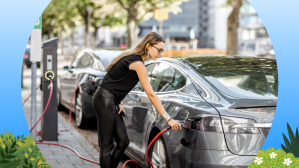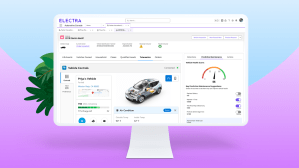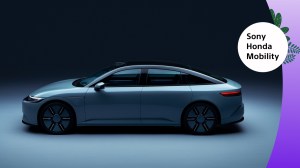Editor’s note: Einstein 1 Platform is now the Salesforce Platform. For the latest, go here.
For decades, motorists on long road trips have had to stress over their fuel gauges inching toward empty with the nearest gas station still miles away. Now, with more electric vehicles (EVs) hitting the roads, their worries are shifting toward the possibility of running out of battery power.
This “range anxiety” is a huge issue for potential EV buyers. In fact, concerns about range (75%) and charge time (73%) are among the top reasons drivers say they would not purchase an EV. Only cost (83%) is a more pressing concern, according to a recent poll from the Energy Policy Institute.
So, how can automakers and energy providers overcome charging and range anxiety while improving the EV ownership experience? Education, data, and connectivity innovation hold the answer.
Educating EV drivers
“People need to feel confident they can find a charging station as easily as they can find a gas station today. But a big part of this is also about charging speed and experience,” said Achyut Jajoo, SVP of Manufacturing and Automotive for Salesforce. “I think it’s an education issue.”
People need to feel confident they can find a charging station as easily as they can find a gas station today. But a big part of this is also about charging speed and experience. I think it’s an education issue.
Achyut Jajoo, SVP of Salesforce Manufacturing and Automotive.
For Jajoo, the lack of adequate EV education for drivers hits close to home.
His son recently took a trip in an EV for the first time, driving from New York City to Washington, D.C. On the journey, he could only find one slow-speed charging station and called his father after discovering that it would take up to an hour to recharge. Luckily, Jajoo was with an EV owner at the time, who told his son where to find a more efficient charger. With that information, Jajoo’s son was charged and back on the road in 15 minutes.
According to Jajoo, his son’s momentary anxiety could have been avoided if he’d had access to tools for locating the best charging options along his route.
Salesforce’s Automotive Cloud platform was built to address just these kinds of situations.
Automotive Cloud helps auto companies deliver connected, personalized experiences to every customer, whether they are driving, buying, or servicing their vehicle. It uses Salesforce Data Cloud, which is embedded in the Einstein 1 Platform, to unify vehicle and driver data — from telematics data to service records to customer preferences — to deliver more personalized driving experiences.
New features for Automotive Cloud will also make it easy for automakers and service teams to visualize and act on their customers’ charging needs in real time based on key telemetry and usage metrics such as location, speed, and energy consumption. Automakers can use all of that information to train artificial intelligence (AI) through Einstein or their own custom models and deliver predictive alerts to EV drivers, such as which charging stations to avoid due to their slow charging speeds and reminders to make a reservation at upcoming charging stations based on their driving patterns.
“If we can tap into that usage data and pair that with everything we know about the consumer and their preferences – which Salesforce makes it easy to do – we can suddenly start providing intelligent personalized contextual experiences,” said Jajoo.
Winnebago’s all-electric RV
Winnebago is one of several automakers evaluating Automotive Cloud to enhance the EV driving experience. The iconic 66-year-old recreational vehicle (RV) company, which launched an all-electric RV prototype in 2023 called the eRV2, is exploring how Automotive Cloud could help it combine customer data with vehicle data to further improve its Winnebago Connect system.
This system unites onboard sensors and devices to deliver more comfort and convenience to RVing — from controlling all systems with real-time notifications to proactive smart energy management. In the future, Winnebago Connect might be used to deliver service and charging recommendations to EV drivers through their mobile devices and customer service team engagements.
“We knew if we were to come out with an electric RV, it would have to be connected. It would have to push the boundaries of technology, not simply on an electrification standpoint,” said Kunal Mehta, VP of Strategy, Business Development, and Marketing at Winnebago. “The eRV2 program is our vision of the future. It incorporates electrification, connectivity, sustainability, and design.”
We knew if we were to come out with an electric RV, it would have to be connected. It would have to push the boundaries of technology, not simply on an electrification standpoint.
Kunal Mehta, VP of Winnebago Strategy, Business Development, and Marketing
Down the road, this connected data will be critical for telling drivers how long it will take to charge their vehicle and house batteries based on their current energy usage or how much battery power it will take to reroute to a charging station.
“We see a future where it allows our customers to help find local charging stations and be more predictive and prescriptive to reduce that charging anxiety for them,” said Kim Weckert, Winnebago’s VP of Digital Transformation.
The role of energy providers
Energy providers also have a considerable role to play in educating current and potential EV drivers, even though research finds that only 4% of consumers use their utilities as a source of information about EVs. That’s where Salesforce’s Energy and Utilities (E&U) Cloud comes into play.
This industry-specific digital platform for customer engagement helps energy and utility providers analyze data from smart meters, ecommerce profiles, and service interactions to connect with customers who are likely to purchase an EV or have recently done so by understanding which of them:
- Have usage profiles that indicate they may already be charging electric vehicles at home.
- Have solar or battery systems installed in their home.
- Have internet-connected home energy management systems. Research shows people with electric vehicles are more likely to also have these systems.
- Live in an area with multiple EV owners, and are more likely to purchase an EV.
- Have recently purchased EV accessories, such as charging adapters, or have applied for EV-related rebates.
With this data enriched profile, energy providers can provide hesitant buyers or new EV owners with useful information about e-mobility programs, partnerships with public charging networks in their area, and charging speed differences between charging ports.
Bringing down costs for converted EV drivers
Once customers take the leap into EV ownership, Salesforce’s E&U Cloud can also help energy companies guide their customers toward cost savings through:
- EV charging installation rebate programs.
- Calculators to help understand savings on gasoline and emissions each year by going partially or completely electric.
- Information on when to charge their EV to maximize cost savings.
“We have a lot of data in Salesforce and via integration, and now with Data Cloud, about customers, preferences, bills, energy use, behavior patterns, and their physical location,” said Kelly James, SVP of E&U Cloud for Salesforce. She said that energy companies can use this information to ensure their customers are gaining the maximum financial benefit from their EV.
The future of EV charging
It’s estimated that 438 charging posts will need to be installed in the U.S. every day by the end of 2030 to keep up with demand, according to the Alliance for Automotive Innovation. That means constructing nearly three chargers every 10 minutes.
And as the number of these public and private charging stations increases, AI will play a key role in ensuring everything stays coordinated and functional — and that the energy grid can handle any increased demand.
“AI is more and more critical in grid load forecasting,” said James. “So in predicting peak demand periods, in driving signals that help adjust charging patterns in near real time to reduce a strain on the grid.“
But beyond relying on AI, James said automakers, energy companies, and governments must always plan for an electrified future with humans in mind.
“We all need to make sure that we continue to deeply care about the customer, the driver, the owners of these vehicles, and their experience.”
More information:
- Learn more about Salesforce Automotive Cloud
- Learn more about Salesforce Energy & Utilities Cloud
- See how energy providers can use Energy & Utilities Cloud Clean Energy Program Management to drive EV adoption
- Hear how Salesforce will power the future of software-defined vehicles from Achyut Jajoo, SVP & GM of Manufacturing & Automotive at Salesforce





















